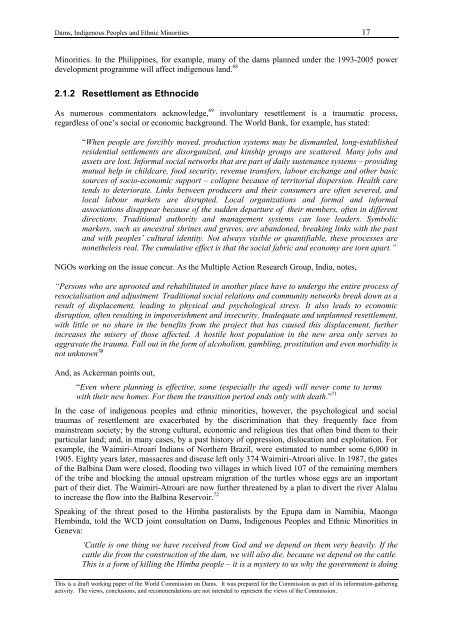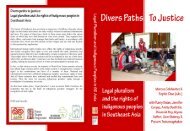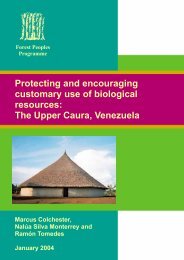Thematic Review II.2: Dams, Indigenous Peoples and Ethnic Minorities
Thematic Review II.2: Dams, Indigenous Peoples and Ethnic Minorities
Thematic Review II.2: Dams, Indigenous Peoples and Ethnic Minorities
Create successful ePaper yourself
Turn your PDF publications into a flip-book with our unique Google optimized e-Paper software.
<strong>Dams</strong>, <strong>Indigenous</strong> <strong>Peoples</strong> <strong>and</strong> <strong>Ethnic</strong> <strong>Minorities</strong> 17<br />
<strong>Minorities</strong>. In the Philippines, for example, many of the dams planned under the 1993-2005 power<br />
development programme will affect indigenous l<strong>and</strong>. 68<br />
2.1.2 Resettlement as Ethnocide<br />
As numerous commentators acknowledge, 69 involuntary resettlement is a traumatic process,<br />
regardless of one’s social or economic background. The World Bank, for example, has stated:<br />
“When people are forcibly moved, production systems may be dismantled, long-established<br />
residential settlements are disorganized, <strong>and</strong> kinship groups are scattered. Many jobs <strong>and</strong><br />
assets are lost. Informal social networks that are part of daily sustenance systems – providing<br />
mutual help in childcare, food security, revenue transfers, labour exchange <strong>and</strong> other basic<br />
sources of socio-economic support – collapse because of territorial dispersion. Health care<br />
tends to deteriorate. Links between producers <strong>and</strong> their consumers are often severed, <strong>and</strong><br />
local labour markets are disrupted. Local organizations <strong>and</strong> formal <strong>and</strong> informal<br />
associations disappear because of the sudden departure of their members, often in different<br />
directions. Traditional authority <strong>and</strong> management systems can lose leaders. Symbolic<br />
markers, such as ancestral shrines <strong>and</strong> graves, are ab<strong>and</strong>oned, breaking links with the past<br />
<strong>and</strong> with peoples’ cultural identity. Not always visible or quantifiable, these processes are<br />
nonetheless real. The cumulative effect is that the social fabric <strong>and</strong> economy are torn apart.”<br />
NGOs working on the issue concur. As the Multiple Action Research Group, India, notes,<br />
“Persons who are uprooted <strong>and</strong> rehabilitated in another place have to undergo the entire process of<br />
resocialisation <strong>and</strong> adjustment Traditional social relations <strong>and</strong> community networks break down as a<br />
result of displacement, leading to physical <strong>and</strong> psychological stress. It also leads to economic<br />
disruption, often resulting in impoverishment <strong>and</strong> insecurity. Inadequate <strong>and</strong> unplanned resettlement,<br />
with little or no share in the benefits from the project that has caused this displacement, further<br />
increases the misery of those affected. A hostile host population in the new area only serves to<br />
aggravate the trauma. Fall out in the form of alcoholism, gambling, prostitution <strong>and</strong> even morbidity is<br />
not unknown 70<br />
And, as Ackerman points out,<br />
“Even where planning is effective, some (especially the aged) will never come to terms<br />
with their new homes. For them the transition period ends only with death.” 71<br />
In the case of indigenous peoples <strong>and</strong> ethnic minorities, however, the psychological <strong>and</strong> social<br />
traumas of resettlement are exacerbated by the discrimination that they frequently face from<br />
mainstream society; by the strong cultural, economic <strong>and</strong> religious ties that often bind them to their<br />
particular l<strong>and</strong>; <strong>and</strong>, in many cases, by a past history of oppression, dislocation <strong>and</strong> exploitation. For<br />
example, the Waimiri-Atroari Indians of Northern Brazil, were estimated to number some 6,000 in<br />
1905. Eighty years later, massacres <strong>and</strong> disease left only 374 Waimiri-Atroari alive. In 1987, the gates<br />
of the Balbina Dam were closed, flooding two villages in which lived 107 of the remaining members<br />
of the tribe <strong>and</strong> blocking the annual upstream migration of the turtles whose eggs are an important<br />
part of their diet. The Waimiri-Atroari are now further threatened by a plan to divert the river Alalau<br />
to increase the flow into the Balbina Reservoir. 72<br />
Speaking of the threat posed to the Himba pastoralists by the Epupa dam in Namibia, Maongo<br />
Hembinda, told the WCD joint consultation on <strong>Dams</strong>, <strong>Indigenous</strong> <strong>Peoples</strong> <strong>and</strong> <strong>Ethnic</strong> <strong>Minorities</strong> in<br />
Geneva:<br />
‘Cattle is one thing we have received from God <strong>and</strong> we depend on them very heavily. If the<br />
cattle die from the construction of the dam, we will also die, because we depend on the cattle.<br />
This is a form of killing the Himba people – it is a mystery to us why the government is doing<br />
This is a draft working paper of the World Commission on <strong>Dams</strong>. It was prepared for the Commission as part of its information-gathering<br />
activity. The views, conclusions, <strong>and</strong> recommendations are not intended to represent the views of the Commission.

















